|
The purple honeycreeper (Cyanerpes caeruleus) is a small bird in the tanager family. It is found in the tropical New World from Colombia and Venezuela south to Brazil, and on Trinidad. A few, possibly introduced birds have been recorded on Tobago.
The purple honeycreeper is 11.5 cm long, weighs 12 g and has a long black decurved bill. The male is purple with black wings, tail and belly, and bright yellow legs. Females and immatures have green upperparts, and green-streaked yellowish-buff underparts. The throat is cinnamon, and there is a blue moustachial stripe. The call of purple honeycreeper is a thin high-pitched zree. The Trinidadian subspecies C. c. longirostris has a longer bill than the mainland forms. This is a forest canopy species, but also occurs in cocoa and citrus plantations. At the upper limit of its altitudinal range, it frequents premontane rainforest, usually rather low-growing (10–15 m) and full of epiphytes and mosses. The purple honeycreeper is often found in small groups. It feeds on nectar (particularly from bromeliad and similar flowers, to which its bill shape is adapted), berries and insects, mainly in the canopy. It is a bold and inquisitive bird, responding readily to the call of the ferruginous pygmy owl (Glaucidium brasilianum) by coming out of cover and searching for the presumed predator to mob it. The female purple honeycreeper builds a small cup nest in a tree, and incubates the clutch of two brown-blotched white eggs. Purple honeycreeper photographed by Rachel Lee Young at Yerette Hummingbird Sanctuary, Maracas St Joseph.
0 Comments
The blue-chinned sapphire (Chlorestes notata) is a hummingbird that breeds from Colombia south and east to the Guianas, Trinidad, Peru, and Brazil. There have been occasional records from Tobago.
It is a bird of forests and sometimes cultivated areas with large trees. The female lays her eggs in a deep cup nest, made of lichen and other fine plant material and placed on a horizontal tree branch. Incubation is 16 days with a further 18–19 days to fledging. The blue-chinned sapphire is 8.9 cm long and weighs 3.8 g. The bill is fairly straight, with the upper mandible black and the lower reddish. The male has mainly green plumage, darker above, with white thighs, a forked metallic blue tail and blue upper throat. The female differs from the male in that she has green-spotted white underparts. Blue-chinned sapphires feed on insects and nectar, mainly in trees but sometimes on vines or smaller plants like Heliconia. The song is a high metallic ssooo-ssooo-ssooo. Blue chinned sapphire feeding on the flowers of Antigua Heath photographed by Rachel Lee Young in the RAPSO garden, Diego Martin. The white-necked jacobin (Florisuga mellivora) is a large and attractive hummingbird that ranges from Mexico, south to Peru, Bolivia and south Brazil. It is also found on Tobago (sub-species F. m. flabellifera) and in Trinidad (sub-species F. m. mellivora)
The white-necked jacobin is approximately 12 cm long and is a widespread inhabitant of forest, usually being seen at a high perch or just above the canopy. It is less common at lower levels, except near hummingbird feeders. The white-necked jacobin is remarkable for its dazzling plumage and unique wing structure, which makes it extremely adept at maneuvering with incredible agility through the forest. The male of this species has a shimmering blue head and chest, and bright iridescent green upperparts. This contrasts starkly with the snow-white plumage of the belly, the broad white crescent on the back of the neck, and the white tail, which is tipped with black. The plumage of female white-necked jacobins is highly variable; a female may have the same plumage as a male, and only be distinguished by its longer bill and shorter wings and tail, or it may differ from the male by having blue-green on the breast, a dull white belly, and a mostly green tail with a dark blue tip. Both the male and female have black feet and a straight black bill These birds usually visit flowers of tall trees and epiphytes for nectar, and also hawk for insects. During the breeding season, the fantastic plumage of the male white-necked jacobin is most prominent, as it performs an attractive territorial display. A male will shoot up into the air, suddenly fan out its white tail, and then slowly descend as it steadily turns, displaying the tail in its full glory to a watching female. Such displays often take place at considerable heights, up in the forest canopy. The white-necked jacobin nests in the forest understorey, one to three metres above the ground, where it constructs a shallow nest of soft vegetation and cobwebs on the surface of a broad leaf, which is sheltered from above by another large leaf. White necked Jacobin photographed by Rachel Lee Young at Yerette Hummingbird Sanctuary, Maracas St Joseph. The black-throated mango (Anthracothorax nigricollis) is a mainly South American hummingbird species. It breeds from Panama south to north easterm Bolivia, southern Brazil and northern Argentina. It is also common on both Trinidad and Tobago. It is a local or seasonal migrant, with some birds moving up to 1000 miles, although its movements are not well understood.
It is 10.2 cm long and weighs 7.2g. The longish black bill is slightly decurved. The tail in both sexes has dark central feathers, the outer tail being wine-red tipped with black. The male has glossy bright green upperparts. His throat and chest are matt black, bordered with blue-green. The flanks are bright green, and the black of the chest tapers onto the belly. The female black-throated mango has bronze-green upperparts and white underparts with a black central stripe. Immature birds show some grey or buff feather tips on the head and wings, and have brown around the eyes. Black-throated mangos inhabits open country, gardens and cultivation. They feed on nectar, often taken from the flowers of large trees and are also notably insectivorous, often hovering in open areas to catch flying insects. The call is a high-pitched tsiuck, and the song is a buzzing hsl-hsl-hsl-hsl-hsl-hsl-hsl. The black-throated mango's breeding season lasts almost year-round in most of its range. It builds a tiny cup nest on a high, thin, and usually bare branch. For this it uses fluff like seed down, cladding the outside with lichen. Nests are maybe 35–40 mm wide and 25–30 mm tall on the outside and some 25 mm wide and 10–15 mm deep inside. The two all-white eggs measure c.15 by 9.5 mm. They are incubated by the female for 16 or 17 days, and fledging takes another 24. This species is very similar to the closely related green-breasted mango. Although the male black-throated mango has more extensive black on the underparts, this and other plumage differences are not always easy to confirm in the field because the birds appear all-black. The females of the two species can be almost inseparable, although the black-throated lacks the more extensively coppery upperpart of its relative. Black throated mango (female) photographed by Rachel Lee Young in the RAPSO garden, Diego Martin Black throated mango (male) photographed by James B Solomon at Adventure Farm Eco Villas, Tobago The long-billed starthroat (Heliomaster longirostris) is a hummingbird that breeds from southern Mexico to Panama, from Colombia south and east to Bolivia and Brazil, and on Trinidad. It is present throughout South and Central America and is an uncommon but widespread species, which appears to be a local or seasonal migrant, although its movements are not well understood.
The long-billed starthroat hummingbird's greatest range is east of the Andes and covers the entire Amazon Basin and northern South America including the Guianas. This hummingbird inhabits forest, and is usually seen in woodland clearings, but will sometimes visit gardens. The female long-billed starthroat lays two eggs in a small cup nest in a tree. The long-billed starthroat is 10.2 cm long and weighs 6.8 g. The black bill is straight and very long, at about 3.5 cm. The male has bronze-green upperparts, a blue crown, white moustachial stripe and reddish throat. The underparts are grey shading to white on the flanks and mid-belly, and the tail is mainly black. The female is similar, but has a green crown and a purple-edged black throat. Long-billed starthroats feed on nectar, taken from a variety of flowers, and some insects. The song of this species while feeding is a light weet. Long billed starthroat photographed by Rachel Lee Young at Yerette Hummingbird Sanctuary, Maracas St Joseph The copper-rumped hummingbird (Amazilia tobaci) is a small bird that breeds in Venezuela, Trinidad and Tobago. It is the predominant species of hummingbird in Trinidad and Tobago.
This hummingbird inhabits open country, gardens and cultivation. The female copper-rumped hummingbird lays its eggs in a tiny cup nest on a low branch, or sometimes wires or clotheslines. Incubation takes 16–17 days, and fledging another 19-23, and there may be up to three broods in a season. The copper-rumped hummingbird is 8.6 cm long and weighs 4.7 g. The bill is fairly long, straight and mostly black with some pink on the lower mandible. The adult has copper-green upperparts, becoming copper-bronze on the rump. The head and underparts are bright green, the thighs are white and the tail and legs are black. The sexes are similar. The food of this hummingbird is nectar, taken from a wide variety of flowers, and some small insects. Copper-rumped hummingbirds perch conspicuously and defend their territories aggressively against other hummingbirds, bees, and larger bird species; this is especially during mating season, which is early in the year. The call of this species is a chip, and the song is a high-pitched tyee-tyee-tyoo. Copper-rumped hummingbird photographed by Rachel Lee Young in the RAPSO garden, Diego Martin The ruby-topaz hummingbird (Chrysolampis mosquitus), commonly referred to simply as the ruby topaz, is a small bird that breeds in the Lesser Antilles and tropical northern South America from Colombia, Venezuela and the Guyanas, south to central Brazil and northern Bolivia; also from Colombia into southern Panama. It is the only member of the genus Chrysolampis. It is a seasonal migrant, although its movements are not well understood.
This hummingbird inhabits open country, gardens and cultivation. It is 8.1 cm long and weighs 3.5 g. Compared to most other hummingbirds, the almost straight, black bill is relatively short. The male has green-glossed dark brown upperparts. The crown and nape are glossy red, and the throat and breast are brilliant golden-orange. The rest of the underparts are brown, and the chestnut tail is tipped black. The male often looks very dark, until he turns and the brilliant colours flash in the sunlight. The female ruby-topaz hummingbird has bronze-green upperparts and pale grey underparts. The tail is chestnut with a dark subterminal band and a white tip. Females from Trinidad typically have a greenish throat-streak (it may appear dark), but this is not common elsewhere in its range. Juvenile females are similar to adult females, but with a white-tipped dusky-brown tail. Juvenile males resemble the juvenile female, but with a variable amount of iridescent orange to the throat. The female ruby-topaz hummingbird lays two eggs in a tiny cup nest in the fork of a low branch. Incubation takes 16 days, and fledging another 18 or 19. The food of this species is nectar, taken from a wide variety of flowers, and some small insects. Ruby-topaz hummingbird males perch conspicuously and defend their territories aggressively. The call of this species is a high-pitched tsip. Ruby Topaz photographed by Rachel Lee Young in the RAPSO garden, Diego Martin |
AuthorRachel Lee Young. Photographer Archives
January 2020
Categories |

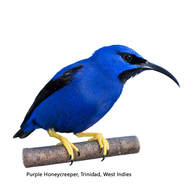
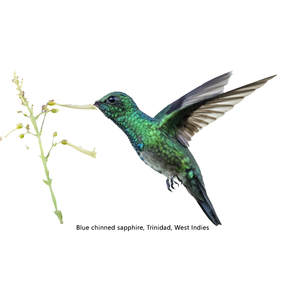
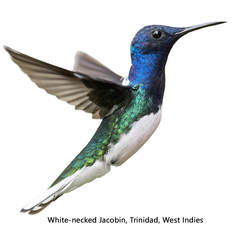
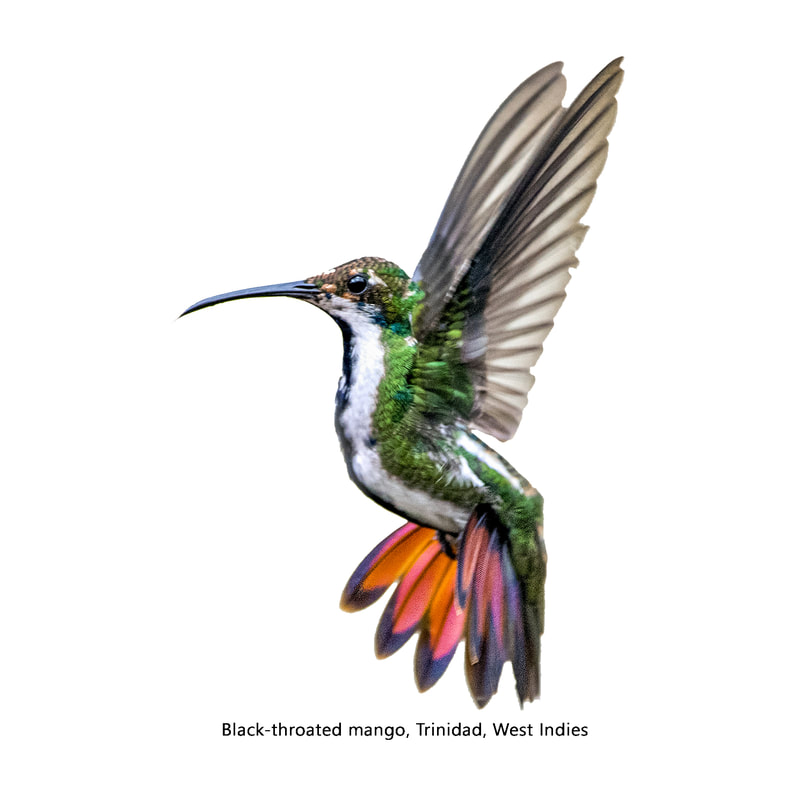
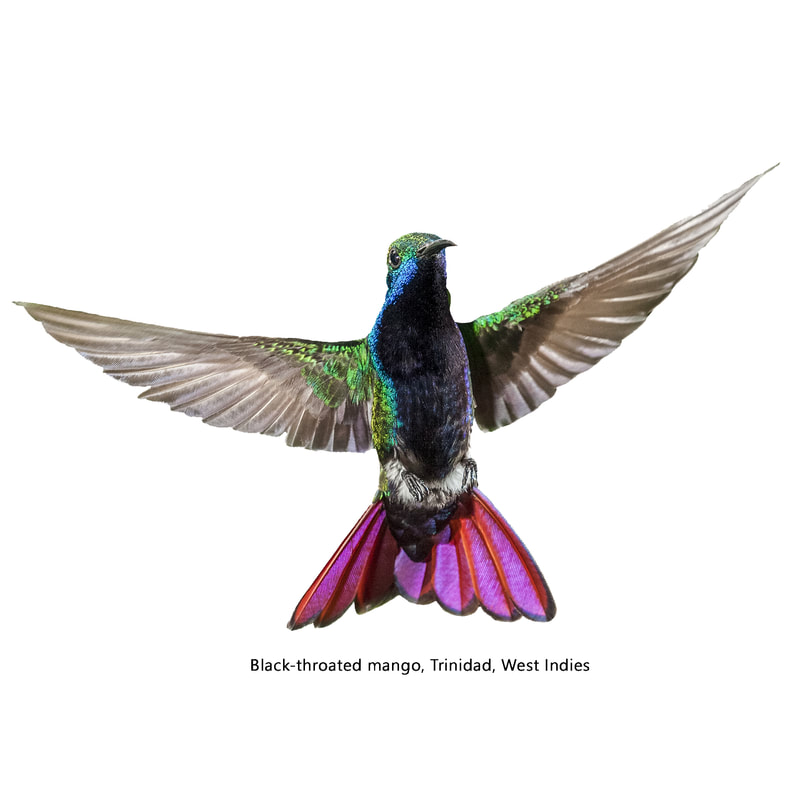
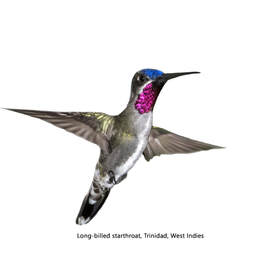
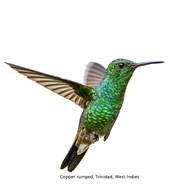
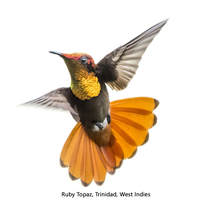
 RSS Feed
RSS Feed
